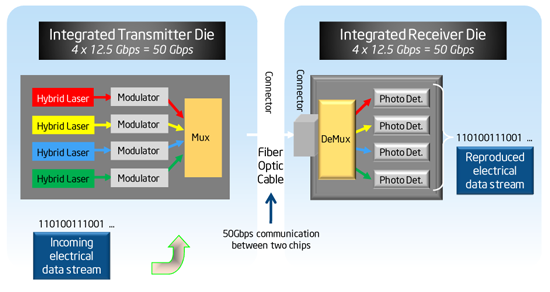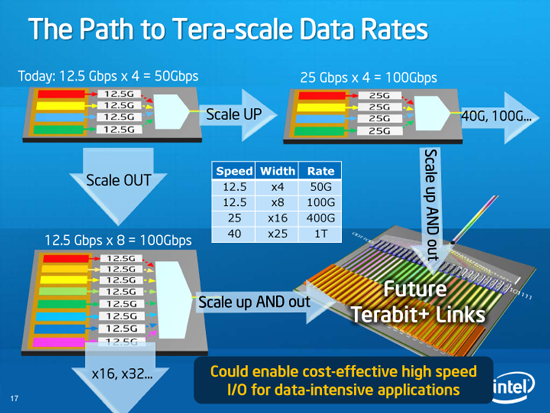Intel's 50Gbps Silicon Photonics Link: The Future of Interfaces
by Brian Klug on July 30, 2010 6:49 AM EST- Posted in
- Trade Shows
- Intel
- Photonics
- Laser
Scaling up (bitrate) and out (WDM)
Intel demonstrated an effective speed of 12.5 gigabits/s per wavelength. Using wavelength division multiplexing (WDM), one can increase the number of wavelengths (or channels) in the fiber, effectively adding more bandwidth. Intel calls this 'scaling out.' This is what’s done in virtually every long haul fiber optic telecommunications network. Even though each wavelength in conventional teleco systems might only be 10 or 20 gigabits/s, the fiber itself can carry many wavelengths, resulting in much higher aggregate bandwidth for a single fiber.

Wavelength Division Multiplexing (WDM)
One can also increase the bitrate of each channel, intel calls this 'scaling up.'

Intel’s demonstration is effectively a vastly miniaturized end to end fiber optic telecommunications system. Instead of cities, you’ve got CPUs and ICHs. Instead of a rack of modulators and optical multiplexers, you’ve got one chip on both ends. The links between components are inevitably going optical, the same way growing need for more and more bandwidth drove almost all terrestrial communications into fiber optic networks.
Both this 50G silicon photonics link and Light Peak are at the core of Intel’s overall I/O strategy for the future, one where copper data links are supplanted almost entirely by optical fibers. No doubt copper will still live on - one still needs to bring power to devices - but in a reduced capacity.
Light Peak is what Intel is calling its first consumer implementation of an external optical bus, and will start at 10 gigabits per second, and will start appearing in products sometime in 2010. The bus will support multiple protocols as well - in theory, you could send USB, ethernet, audio, and video at super fast rates over one unified optical connection. If you think about the same thing happening but on the motherboard, you’ll get a sense for the beginning of how optical data connections will supplant copper.
Hopefully some day we’ll be talking about replacing electrons in microprocessors with photons, and computing entirely with light. Optical computing poses a host of challenges before it can be fully realized, but eventually Intel might replace ICs with photonic equivalents entirely. That future is still decades away, but until then we’ll definitely be using optical busses for moving data around.










42 Comments
View All Comments
ghot - Thursday, August 5, 2010 - link
"Blinded by the light...." I'm 53 years old and having been waiting for this since the 1st TI calculator hit the market in 1976. Unfortunately I probably won't live to see the 1st totally optical, consumer affordable PC.This doesn't prove 'Murphy's Law....it squares or even cubes it.
The best part, isn't even the speed (although it will be incredible) but rather the fact that PCB printed circuits can be a long as the design requires. Imagine a motherboard 5 inches wide and 3-4 foot tall. Then a PC enclosure could look more like a 4 foot tall 6x6 inch speaker enclosure for example.
Cooling needs will be greatly reduced as well. Just try to imagine the over clocking potential.
I used to drool over the 1st commercially available digital watch...the Pulsar....didn't even have LED's...it used tiny Nixie Tubes.....and now this.
When most of you are my age, you'll be complaining that your brand new Intel P4 (yes P4..maybe in YOUR lifetime, Intel will get back to simple naming schemes) is only capable of 4Thz on air. And, as every over clocker knows....increase the speeds in small increments...say .....10Ghz each time...lol
I am so jealous :)
ziaullahk - Sunday, February 18, 2018 - link
And to think about it, we just reached 100GBps according to https://compoundtek.com/news